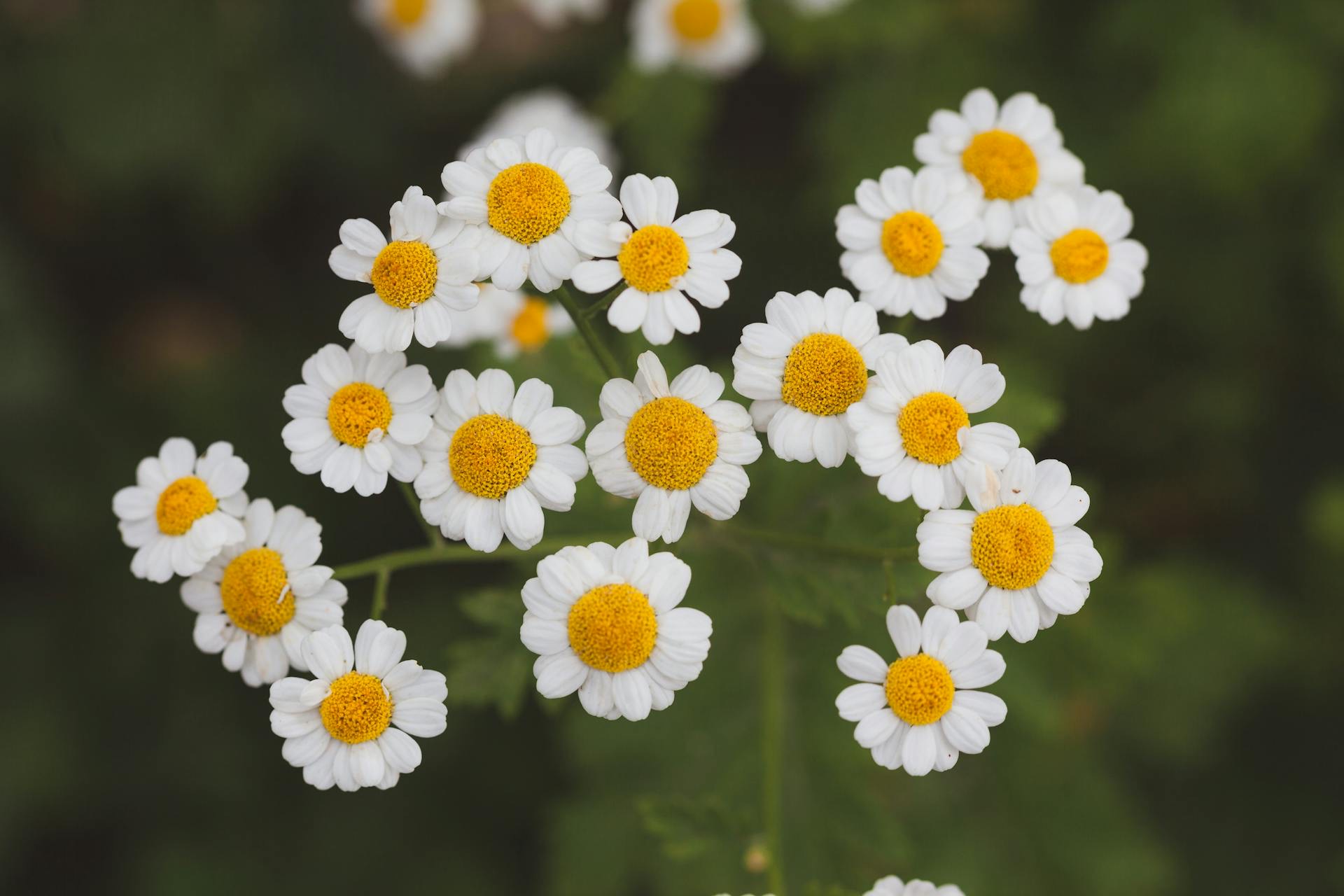Botanical Basics
- Common Name(s): Feverfew
- Folk Name(s): Featherfew, Midsummer Daisy, Medieval Aspirin, Bride’s Button
- Scientific/Latin Name: Tanacetum parthenium
- Family: Asteraceae (Daisy family)
- Plant Type: Perennial herb
- Botanical Description: Feverfew grows 1–2 feet tall, with light green, pinnate leaves that have a strong, bitter aroma. It produces small daisy-like flowers with yellow centers and white rays, blooming in summer.
- Growing Zones/Climate: USDA zones 5–9; prefers temperate climates.
- Best Zones for Growth: Thrives in zones 5–8 with moderate winters and warm summers.
- Habitat & Range: Native to southeastern Europe and the Balkans; now naturalized across Europe, North America, and temperate regions worldwide.
Cultivation & Harvest
- Soil & Sun Requirements: Well-drained soil; prefers loamy to sandy soils. Full sun is best, though it tolerates partial shade.
- Propagation: By seed (sown in spring or fall), cuttings, or root division. Self-seeds easily.
- Companion Planting: Works well near roses and other perennials; its pungent aroma can deter insects.
- Harvesting Guidelines: Harvest leaves before flowering for medicinal use; flowers may also be gathered when fully open.
- Drying/Preservation: Dry leaves and flowers quickly in a dark, airy place; store in airtight containers away from light.
Traditional & Historical Use
- Cultural Significance: Used since ancient Greece as a fever-reducing herb; mentioned by Dioscorides and other early physicians. A common “household remedy” herb throughout medieval Europe.
- Traditional Medicine: Historically used for fevers, headaches, stomach troubles, and menstrual irregularities. Most famously recognized as a preventative remedy for migraines.
- Symbolism: Associated with protection and health; often planted in cottage gardens for warding illness and evil.
Medicinal & Practical Properties
- Active Constituents: Parthenolide (primary), sesquiterpene lactones, flavonoids, volatile oils.
- Medicinal Uses: Prevents migraines, reduces inflammation, supports menstrual balance, eases arthritis pain, reduces fevers and digestive upset.
- Preparation Methods: Fresh or dried leaf in teas, tinctures, or capsules. Traditionally chewed fresh (though bitter).
- Dosage & Guidelines: 50–150 mg of standardized leaf extract daily; or 1–3 fresh leaves daily (though chewing may cause mouth irritation).
- Safety/Precautions: Not for use during pregnancy (uterine stimulant). May cause mouth sores if chewed fresh. Possible allergic reactions in those sensitive to Asteraceae family. Can interact with blood-thinning medications.
Magical & Spiritual Properties
- Elemental Association: Air
- Planetary/Deity Correspondence: Venus, Mercury (some traditions); associated with healing goddesses such as Hygeia and Brigid.
- Magical Correspondences: Protection, purification, healing, preventing illness, calming the mind.
- Ritual Use: Burned in incense or placed in charm bags for protection; added to healing baths and teas (with caution). Planted near homes as a guardian herb.
- Symbolism in Divination/Dreams: May indicate the need for healing, rest, or warding off negativity. Dreams of feverfew can signify recovery or resilience.
Ecological & Culinary Uses
- Pollinator Value: Attracts bees, hoverflies, and other beneficial insects with its daisy-like flowers.
- Wildlife Uses: Provides nectar and habitat for pollinators; foliage deters some insect pests.
- Culinary Uses: Traditionally chewed fresh for medicine, but not generally considered a culinary herb due to bitterness.
Household/Practical Uses
- Quick Uses: Insect deterrent; protective herb in gardens and home charms.
- Notable Traits: Strong, bitter scent; naturalized easily; medicinally notable for migraine prevention.
- Special Notes: Its name derives from Latin febrifugia—“fever reducer.”

Supporting Notes
- References:
- Chevallier, Andrew. The Encyclopedia of Herbal Medicine.
- Grieve, M. A Modern Herbal.
- Hoffman, David. Medical Herbalism.
- Duke, James A. The Green Pharmacy.
- NIH National Center for Complementary and Integrative Health (NCCIH).
No comments:
Post a Comment